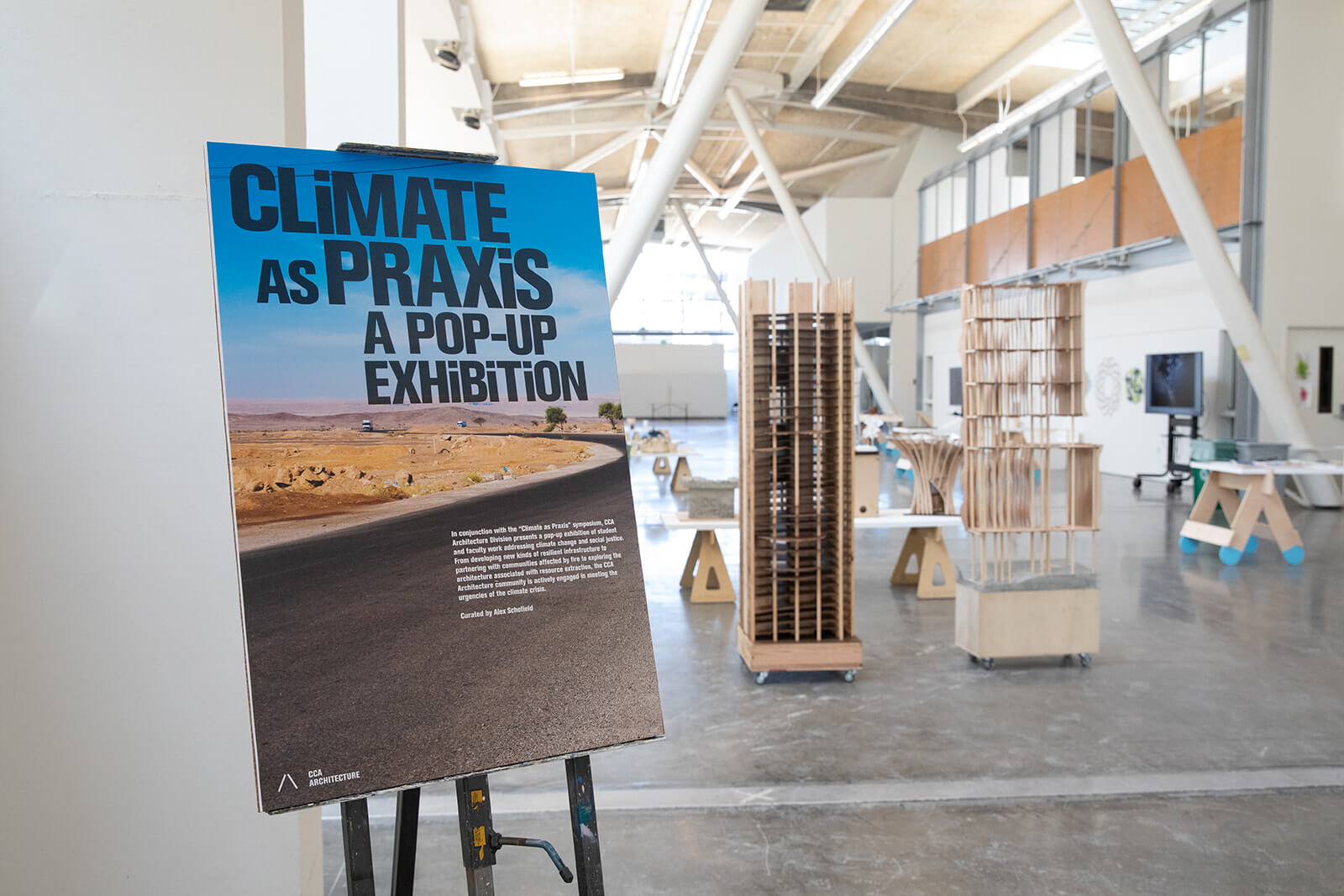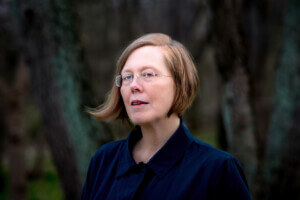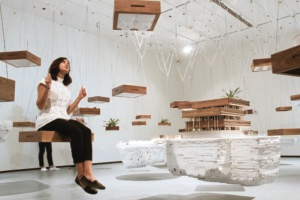Climate as Praxis
CCA Architecture Division
April 15, 2023
The launch of California College of the Arts’ (CCA) Arthur Gensler Jr. Center for Design Excellence came as a welcome contrast to a typical weeknight lecture sprint due to the event’s luxurious, abundant length. Over five rich hours, Climate as Praxis, organized by CCA faculty Irene Cheng, Neeraj Bhatia, and Adam Marcus, presented focused takes from Kate Orff of SCAPE, Chris Cornelius of studio:indigenous, Billie Faircloth of KieranTimberlake, and Boonserm Premthada of Bangkok Project Studio. (All four also have academic appointments that support their research and advocacy in conjunction with private practices.) Across the span of the afternoon, the speakers shared candid reflections on the inspirations for, and challenges to, doing their important work.
The first pair of talks were themed on land and territory. Orff presented on SCAPE’s work, including Oyster-tecture and Living Breakwaters, the Louisiana Gulf Coast Master Plan, and the Chattahoochee RiverLands. She outlined the impact each project was expected to have and the tremendous multistakeholder wrangling required for its realization. “If there is a scale that will melt your brain, students, this is it,” she said of the Louisiana master plan.

The contradictions inherent in Chris Cornelius’s growing body of land-acknowledgment artworks commissioned for university campuses began a fruitful thread of conversation on practice, departing from the typical lecture-series triumph narrative. The pieces include the Indian Community School in Milwaukee; Otāēciah, a permanent land acknowledgment sculpture on the grounds of Lawrence University in Wisconsin; Not My HUD House, a housing prototype commissioned for the Crystal Bridges Museum of American Art Architecture at Home exhibition; and an ongoing illustrated research document exploring the 1969–71 occupation of Alcatraz. Mirroring Orff’s positioning of her work in deep opposition to existing political and social power structures, Cornelius offered insight into the fraught discourse surrounding land acknowledgments as an endpoint: “What would it look like if you gave some of the land back?”
In the panel on materials and tools, Faircloth detailed KieranTimberlake’s commitment to building life cycle–analysis tools and the various implications they have on the design process at a macro level. The office’s projects are “test-beds,” she said, “simply meaning that we can learn from what we make.” Like Orff and Cornelius, Faircloth argued for an expanded definition of the architectural project, but for her that means looking at ways that material extraction and production, longevity, carbon sequestration, and labor conditions could all be quantified to provide meaningful feedback, an abstraction she describes as “a form of advocacy.” Faircloth presented the firm’s 2013 online life cycle–analysis program Tally as an example of one such attempt where the firm produced a tool to satisfy its own research aims. Today, it is available for download by anyone, which exponentially expands its impact.

In contrast to Faircloth’s productive abstraction, Premthada’s work offered detailed specificity and material experience. Images of his Kantana Institute project, a film school he designed of thick, undulating handmade-brick walls in Thailand’s Nakhon Pathom province, were offered as a fertile and changing backdrop for the students’ creative processes. The movement of air, the heft of and imperfections in the rough-hewn brick, and the varied scale of spaces for focus and gathering are all tuned in this project for emotional impact. Premthada offered his own partial deafness as explanation for what he calls a hyper focus on the other senses. His projects for elephants elicited gasps from the audience: His respect and appreciation for the animals (“non-human users”), and in particular his consideration of their experience of light, air, and sound, provided the day’s final and most poetic model for expanding practice. “Animals are humble, so we must be humble to serve them,” Premthada offered as a reflection on the tremendous scale and unique timbre of an elephant’s experience of the world.
Discussions thoroughly probed one of words in the symposium’s title: praxis. Is it method? Technique? Execution? While climate change and pollution ostensibly unified the day’s inquiry, capitalism, private property, property rights, sovereignty, and greed quickly surfaced as exacerbating, difficult-to-address conditions firmly in the mix. In one of the most provocative and direct audience questions, Nancy Levinson, editor and executive director of Places, asked whether the panelists’ praxis challenged the traditional client-centric business model of the architecture profession itself. In response, Faircloth offered that research goes hand in hand with practice at KieranTimberlake, with each feeding the other meaningful data. Orff, on the other hand, criticized the short feedback loop of the market economy as a culpable driver of climate-damage disinterest and instead encouraged the creation of modes of practice that renounce traditional delivery models in favor of robust, long-term entanglements. The important fact that all four practitioners are supported by academic salaries in addition to those earned in practice wasn’t lost on them. Their research-heavy long-term format for architectural inquiry is simply not available to everyone. As Cornelius plainly stated: “I’m not fooling myself or anyone else by saying that the practice is what sustains me in my life. Academia pays the bills. I’m not trying to critique practice, I’m just trying to figure out how to make it work for myself.”

In that sense, the real praxis of Climate as Praxis may be the panelists’ combination of private practice and academic work, with its rare institutional support for advocacy, research, and project development. There is simply not enough time in the traditional design-delivery model to accommodate the other objectives that these practitioners foreground. They must find alternative modes, as it is not enough to care deeply about elephants’ sense of breeze and belonging or to develop tools modeling and comparing material life cycle costs. To support yourself in a market economy, you must also find ways around profit-driven forces to make a change.
If this event is an indication of the direction for future programming, the Gensler Center promises to be a space of digestion and reflection for the CCA and the wider Bay Area architecture community. The symposium demonstrated a commitment to addressing hard problems that deserve our attention and time.
Sarah Hirschman is an architect and a partner at Object Projects. She is a visiting associate teaching professor at Northeastern’s Mills Campus in Oakland, California, where she is building a new architecture program.











